AzureWave Technologies NM387 IEEE 802.11b/g/n Wireless LAN & Bluetooth Module User Manual AW NM387 DS v0 4
AzureWave Technologies, Inc. IEEE 802.11b/g/n Wireless LAN & Bluetooth Module AW NM387 DS v0 4
User Manual

- 1 -
AW-NM387
IEEE 802.11 b/g/n Wireless LAN & Bluetooth
Module
Datasheet
Version 0.4
Document
release Date Modification Initials Approved
Version0.1 2010/06/30 Initial version Max Huang Ivan Chen
Version0.12 2010/7/1
Update page 9 pin out and page 10
reference design Max Huang Ivan Chen
Version0.2 2010/7/8
Update final mechanical
characteristic Scott Hsieh Ivan Chen
Version0.3 2010/7/19 Update Page 10 reference design Scott Hsieh Ivan Chen
Version0.4 2010/8/19 Update Sleep_CLK pin define Scott Hsieh Ivan Chen

- 2 -
1. General Description
1-1. Product Overview and Functional Description
AzureWave Technologies, Inc. introduces the first IEEE 802.11b/g/n WLAN & Bluetooth module IC---
AW-NM387. The module is targeted to mobile devices including Personal Digital Assistants (PDAs),
Netbook, Tablet and Gaming Devices which need small package module, low power consumption,
multiple interfaces and OS support. By using AW-NM387, the customers can easily enable the Wi-Fi ,
and BT embedded applications with the benefits of high design flexibility, short development cycle,
and quick time-to-market.
Compliance with the IEEE 802.11b/g/n standard, the AW-NM387 uses Direct Sequence Spread
Spectrum (DSSS), Orthogonal Frequency Division Multiplexing (OFDM), DBPSK, DQPSK, CCK and
QAM baseband modulation technologies. A high level of integration and full implementation of the power
management functions specified in the IEEE 802.11 standard minimize the system power requirements
by using AW-NM387. In addition to the support of WPA/WPA2 and WEP 64-bit and 128-bit encryption,
the AW-NM387 also supports the IEEE 802.11i security standard through the implementation of
Advanced Encryption Standard (AES)/Counter Mode CBC-MAC Protocol (CCMP), Wired Equivalent
Privacy(WEP) with Temporal Key Integrity Protocol(TKIP),Advanced Encryption Standard(AES)/Cipher-
Based Message Authentication Code(CMAC), and WLAN Authentication and Privacy Infrastructure
(WAPI) security mechanisms.
For the video, voice and multimedia applications the AW-NM387 support 802.11e Quality of Service
(QoS).
For Bluetooth operation, AW-NM387 is Bluetooth 3.0 + High Speed (HS) also complaint with
Bluetooth 2.1 + Enhanced Data Rate (EDR). Bluetooth 3.0 + HS can make it easier to connect
The AW-NM387 supports SDIO for WLAN to the host processor. SDIO interface are available to connect
the BT core the host processor.
AW-NM387 is suitable for multiple mobile processors for different applications. With the support cellular
phone co-existence, the AW-NM387 is also the best solution for mobile phones and PDA phones
applications.
AW-NM387 module adopts Marvell’s latest highly-integrated WLAN & Bluetooth SoC---88W8787. All the
other components are implemented by all means to reach the mechanical specification required.
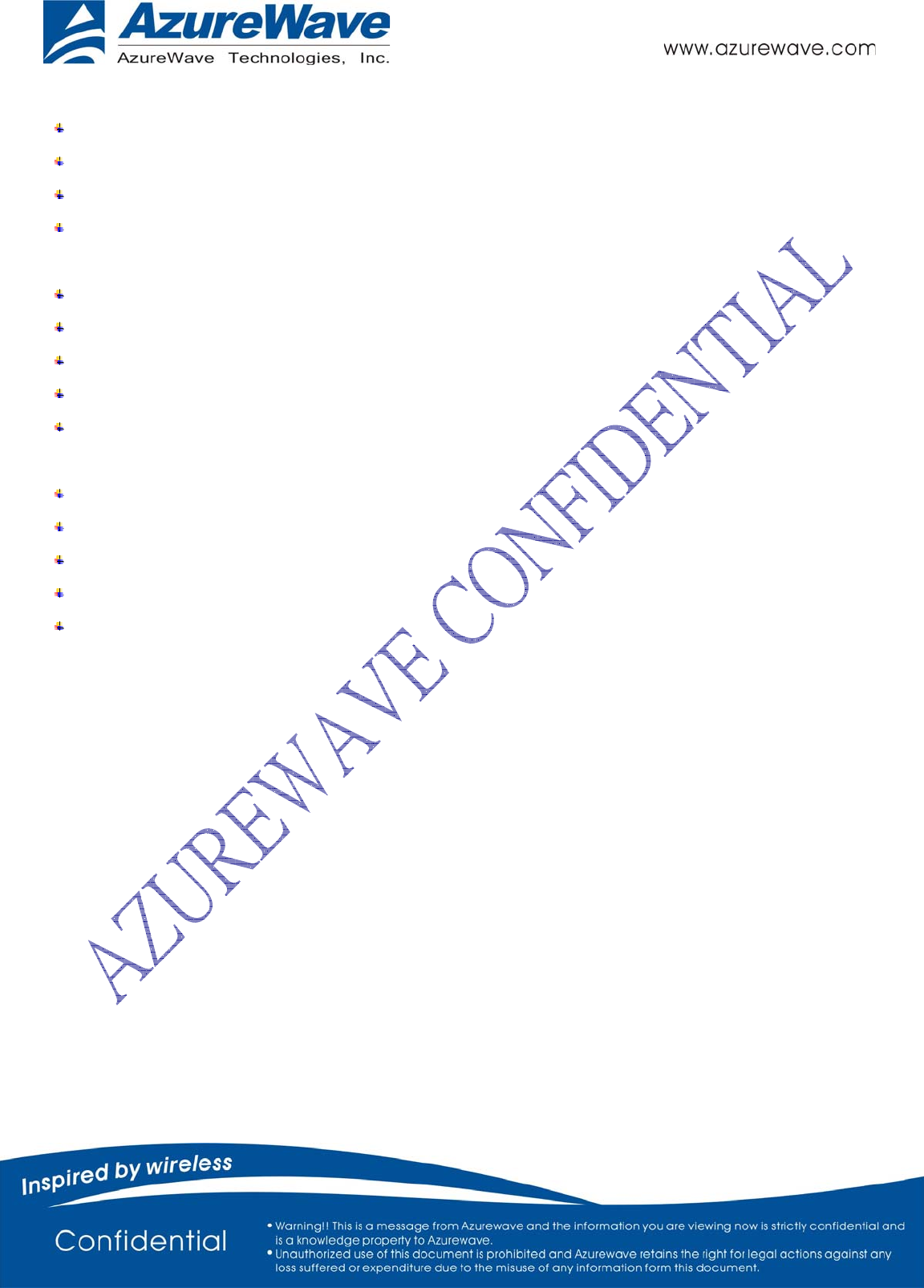
- 3 -
1-2. Key Features
Small footprint: 23mm(L) x 11mm(W) x 2.4 mm(H)
SDIO interfaces support for WLAN
SDIO for Bluetooth
Bluetooth 3.0 + High Speed (HS) also complaint with Bluetooth 2.1 + Enhanced Data
Rate (EDR)
Cellular phone co-existence support
Multiple power saving modes for low power consumption
IEEE 802.11i for advanced security
Quality of Service (QoS) support for multimedia applications
Drip-in WLAN Linux drivers are Android ready and validated on Android based
systems.
Support for Linux kernel versions up to 2.6.32.
Support for BlueZ v4.47 Bluetooth profiles stack used in Android Éclair
Simultaneous AP-STA
Support China WAPI
Lead-free design

- 4 -
2. Block Diagram
3. Specifications Table
3URGXFW'HVFULSWLRQ Wireless LAN &Bluetooth Module
:/$16WDQGDUG IEEE 802.11b/g/n, Wi-Fi compliant
%OXHWRRWK6WDQGDUG Bluetooth 3.0 +high speed complaint with Bluetooth 2.1+Enhanced
Data Rate (EDR)
+RVW,QWHUIDFH WLAN and Bluetooth through SDIO
0DMRU&KLSVHW
Marvell 8787
'LPHQVLRQ 11mm x 23mm x 2.4mm
2SHUDWLQJ&RQGLWLRQV
9ROWDJH 3.3V/1.8V(optional)+/- 10%
7HPSHUDWXUH Operating: -20 ~ 70
o
C ; Storage: -40 ~ 85
o
C
(OHFWULFDO6SHFLILFDWLRQV
)UHTXHQF\5DQJH 2.4 GHz ISM radio band
1XPEHURI&KDQQHOV
802.11b: USA, Canada and Taiwan
–
11
Most European Countries – 13
France – 4, Japan – 14
802.11g: USA, Canada and Taiwan – 11
Most European Countries – 13
Japan – 13
802.11n(HT20): Channel 1~14(2412~2484)
802.11n(HT40): Channel 1~7(2422~2472)
0RGXODWLRQ
DSSS, OFDM, DBPSK, DQPSK, CCK, 16-QAM, 64-QAM for WLAN
GFSK (1Mbps), Ȇ/4 DQPSK (2Mbps) and 8DPSK (3Mbps) for
Bluetooth
2XWSXW3RZHU WLAN:

- 5 -
802.11b(Ch1~13): typical 17dBm +/- 2dBm
802.11b(Ch14): typical 10dBm +/- 2dBm
802.11g: typical 14dBm +/- 2dBm
802.11n: typical HT20 13dBm +/- 2dBm
HT40 12dBm +/- 2dBm
Typical power: Bluetooth
Bluetooth Class 1.5>1dBm
$QWHQQD WLAN&BT through U.FL connector
5HFHLYH6HQVLWLYLW\
WLAN:
802.11b: Minimum -86dBm at 11Mbps
802.11g: Minimum -71dBm at 54Mbps
802.11n: Minimum -68dBm at HT20 MCS7
Minimum -65dBm at HT20 MCS7
Bluetooth:
GFSK: typical -87dBm
Ȇ/4 DQPSK: typical -88dBm
8DPSK: typical -81dBm
0HGLXP$FFHVV3URWRFRO CSMA/CA with ACK
'DWD5DWHV
WLAN
802.11b: 1, 2, 5.5, 11Mbps
802.11g: 6, 9, 12, 18, 24, 36, 48, 54Mbps
802.11n up to 150Mbps
Bluetooth
Bluetooth 2.1+EDR data rates of 1,2, and 3Mbps
2SHUDWLQJ5DQJH
Open Space: ~300m ; Indoor: ~100m for WLAN
Minimum 10 m indoor for Bluetooth
The transmission speed may vary according to the environment)
6HFXULW\
WAPI
WEP 64-bit and 128-bit encryption with H/W TKIP processing
WPA/WPA2 (Wi-Fi Protected Access)
AES-CCMP hardware implementation as part of 802.11i security
standard
&R([LVWHQFH Bluetooth and cell phone(GSM/DCS/WCDMA/UMTS/3G) co-existence

- 6 -
2. Electrical Characteristics
2-1. Absolute Maximum Ratings
Symbol Parameter Condition Min Typ Max Units
3.3V PA and Internal voltage power
supply 3.3 4.6 V
VIO Host I/O power supply
1.8 2.3
V 2.6 3.1
3.3 4.2
External
1.8V
Analog I/O power
supply(optional) 1.8 2.3 V
2-2. Recommended Operating Conditions
Symbol Parameter Condition Min Typ Max Units
3.3V PA and Internal voltage power
supply 3 3.3 3.6 V
VIO Host I/O power supply
1.62 1.8 1.98
V 2.5 2.6 2.7
2.97 3.3 3.63
External
1.8V
Analog I/O power supply
(optional) 1.7 1.8 1.9 V
2-3. Clock Specifications
AW-NM387 has internal reference clock source. The customer doesn’t need to use external CLK.
2-3.1 External Sleep Clock Timing
External Sleep Clock is necessary for two reasons:
1. Auto frequency Detection.
This is where the internal logic will bin the Ref clock source to figure out what is the reference clock
frequency is. This is done so no strapping is needed for telling 8787 what the ref clock input is.
2. Allow low current modes for BT to enter sleep modes such as sniff modes.

- 7 -
The AW-NM387 external sleep clock pin is powered from the 1.8V voltage supply.
Symbol Parameter Min Typical Max Units
CLK Clock Frequency Range 32 or 32.768 -50ppm 32 or 32.768 32 or 32.768 +50ppm kHz
T
HIGH
Clock high time 40 -- -- ns
T
LOW
Clock low time 40 -- -- ns
T
RISE
Clock rise time -- -- 5 ns
T
FALL
Clock fall time -- -- 5 ns
2-4. SDIO Host Interface Specifications
Referred from Marvell hardware specifications
SDIO Protocol Timing Diagram
SDIO Protocol Timing Diagram—High Speed Mode

- 8 -
SDIO Timing Data
Symbol Parameter Condition Min Typ Max Units
f
pp
CLK Frequency
Normal 0 25 MHz
High Speed 0 75
T
WH
CLK High Time Normal 10
ns
High Speed 7
T
WL
CLK Low Time
Normal 10
High Speed 7
T
ISU
Input Setup Time Normal 5
High Speed 6
T
IH
Input Hold Time Normal 5
High Speed 2
T
ODLY
Output Delay Time 0 7.33
T
OH
Output Hold Time High Speed 2.5
2-5. Pin Out Power Supply Use
VIO
PDn
SD_CLK
SD_CMD
SD_DAT[1]
SD_DAT[2]
SD_DAT[3]
WiFi_LED
BT_LED

- 9 -
3. Pin Definition
Pin Assignment
Pin No Definition Basic Description Type
1 GND
2 External
1.8V(optional)
1.8V voltage optional.
Default model is used internal 1.8V, so please keep this pin float.
If the customer wants to use external 1.8V model. Please contact to
AzureWave.
P
3 PDn
Full Power Down(active low as long as system need)
0=power down mode
1=normal mode
(1)Connect to power down pin of host
Note: Needs the external host to driver this pin high for normal operation.
No internal pull-up on this pin.
I
4 VIO 1.8V/2.6/3.3V Host interface voltage P
5 SLEEP_CLK
Sleep Clock Input
Used for WALN, Bluetooth, and FM low-power modes.
External sleep clock of 32.768KHZ must be used for auto reference clock
calibration and for WALN/Bluetooth/FM low power operation.
I
6 GND
7 SD_CMD
SDIO 4-bit Mode: Command/Response
SDIO 1-bit Mode: Command Line
SDIO SPI Mode: Data Input
I/O
8 SD_DAT[0]
SDIO 4-bit Mode: Data line bit[0]
SDIO 1-bit Mode: Data line
SDIO SPI Mode: Data output
I
9 SD_DAT[1]
SDIO 4-bit Mode: Data line bit[1]
SDIO 1-bit Mode: Interrupt
SDIO SPI Mode: Reserved
I/O
10 SD_DAT[2]
SDIO4-bit Mode: Data line bit[2]or Read Wait(optional)
SDIO 1-bit Mode: Read Wait(optional)
SDIO SPI Mode: Reserved
I/O
11 SD_CLK
SDIO 4-bit Mode: Clock Input
SDIO 1-bit Mode: Clock Input
SDIO SPI Mode: Clock Input
I/O
12 SD_DAT[3]
SDIO 4-bit Mode: Data line bit[3]
SDIO 1-bit Mode: Reserved
SDIO SPI Mode: Card Select(active low)
I/O
13 WIFI_LED/GPIO1 WIFI LED function I/O
14 BT_LED/GPIO 17 BT LED function I/O
15 3.3V P
16 3.3V P
17 GND

- 10 -
4. Reference Design Circuit
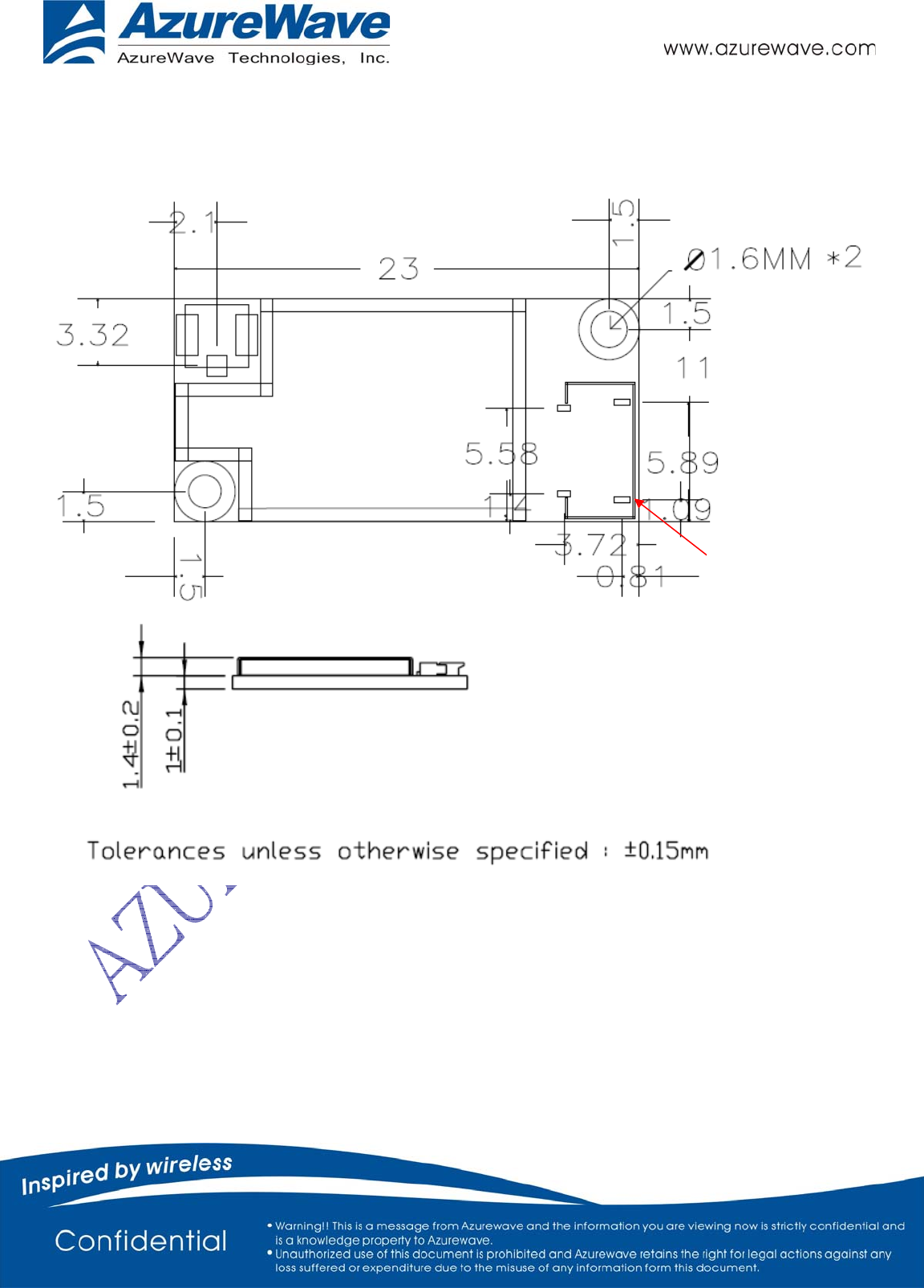
- 11 -
5. Mechanical Characteristic
5.1 Outline
11X23mm
5.2 Applicable FPC
Pin1
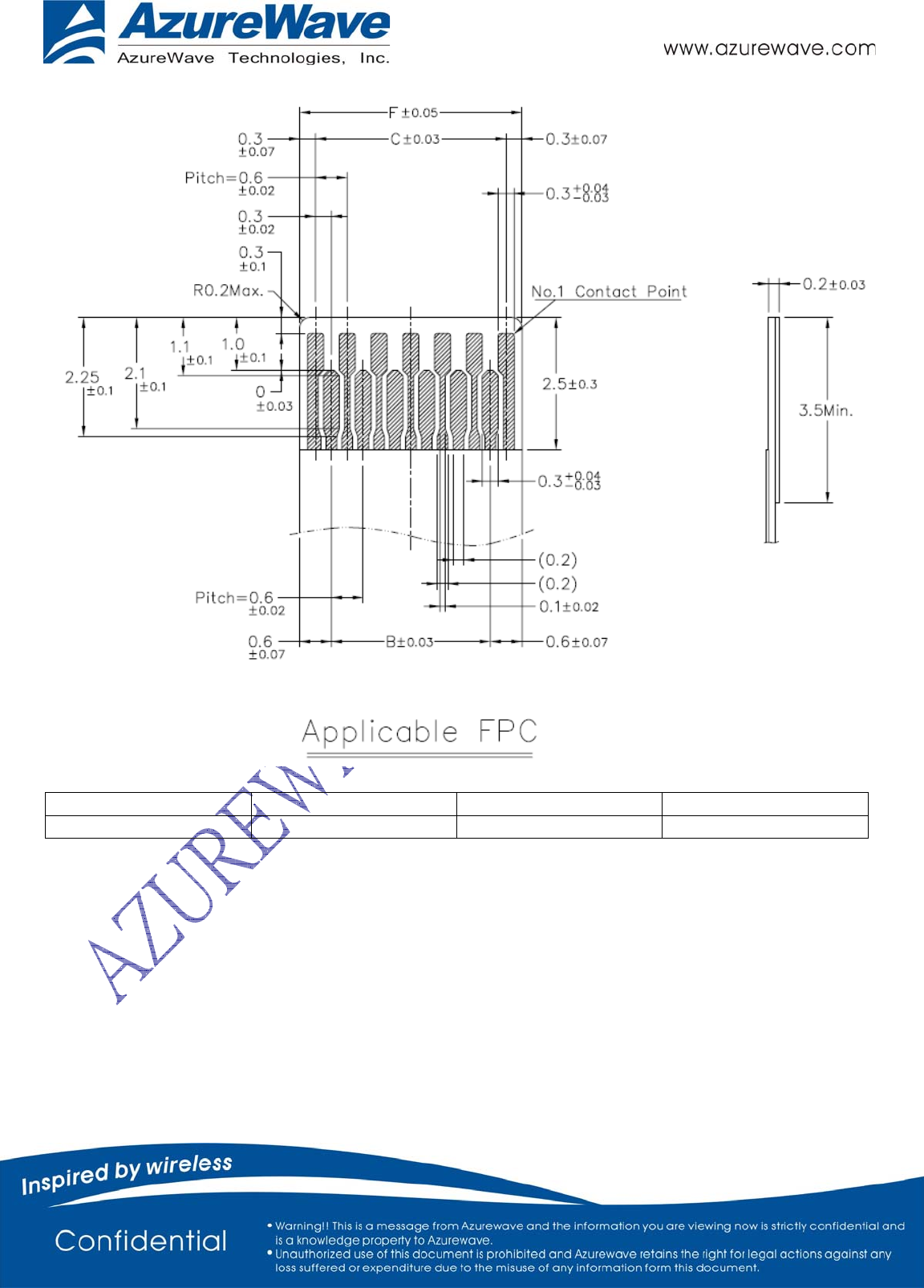
- 12 -
No of Contacts B C F
17 4.2mm 4.8mm 5.4mm
5.3 Connector Insertion Depth of FPC
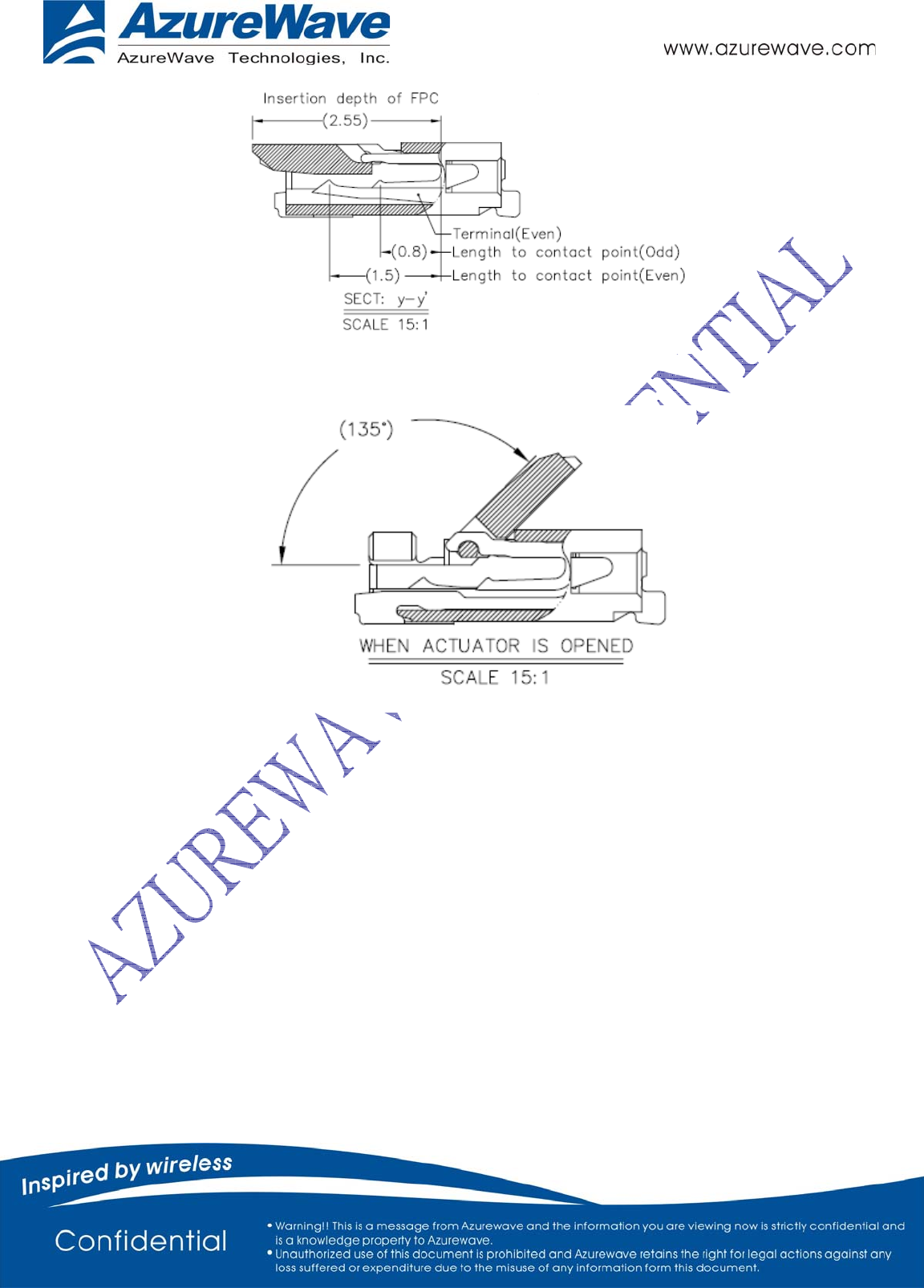
- 13 -
5.4 When Connector Actuator is opened
FCC Notice :
Federal Communication Commission Interference Statement
This equipment has been tested and found to comply with the limits for a Class B digital device,
pursuant to Part 15 of the FCC Rules. These limits are designed to provide reasonable protection
against harmful interference in a residential installation. This equipment generates, uses and can
radiate radio frequency energy and, if not installed and used in accordance with the instructions,
may cause harmful interference to radio communications. However, there is no guarantee that
interference will not occur in a particular installation. If this equipment does cause harmful
interference to radio or television reception, which can be determined by turning the equipment off
and on, the user is encouraged to try to correct the interference by one of the following measures:
- Reorient or relocate the receiving antenna.
- Increase the separation between the equipment and receiver.
- Connect the equipment into an outlet on a circuit different from that
to which the receiver is connected.
- Consult the dealer or an experienced radio/TV technician for help.
FCC Caution: Any changes or modifications not expressly approved by the party responsible for
compliance could void the user's authority to operate this equipment.
This device complies with Part 15 of the FCC Rules. Operation is subject to the
following two conditions: (1) This device may not cause harmful interference, and (2)
this device must accept any interference received, including interference that may
cause undesired operation.
IMPORTANT NOTE:
FCC Radiation Exposure Statement:
This equipment complies with FCC radiation exposure limits set forth for an uncontrolled
environment. This equipment should be installed and operated with minimum distance 20cm
between the radiator & your body.
This transmitter must not be co-located or operating in conjunction with any other antenna or
transmitter.
This device is intended only for OEM integrators under the following conditions:
1) The antenna must be installed such that 20 cm is maintained between the antenna and
users, and
2) The transmitter module may not be co-located with any other transmitter or antenna,
3) For all products market in US, OEM has to limit the operation channels in CH1 to CH11 for

2.4G band by supplied firmware programming tool. OEM shall not supply any tool or info to
the end-user regarding to Regulatory Domain change.
As long as 3 conditions above are met, further transmitter test will not be required. However, the
OEM integrator is still responsible for testing their end-product for any additional compliance
requirements required with this module installed
IMPORTANT NOTE: In the event that these conditions can not be met (for example certain
laptop configurations or co-location with another transmitter), then the FCC authorization is no
longer considered valid and the FCC ID can not be used on the final product. In these
circumstances, the OEM integrator will be responsible for re-evaluating the end product
(including the transmitter) and obtaining a separate FCC authorization.
End Product Labeling
This transmitter module is authorized only for use in device where the antenna may be installed
such that 20 cm may be maintained between the antenna and users. The final end product must be
labeled in a visible area with the following: “Contains FCC ID: TLZ-NM387”.
Manual Information To the End User
The OEM integrator has to be aware not to provide information to the end user regarding how to
install or remove this RF module in the user’s manual of the end product which integrates this
module.
The end user manual shall include all required regulatory information/warning as show in this
manual.
Industry Canada statement:
This device complies with RSS-210 of the Industry Canada Rules. Operation is subject to the following
two conditions: (1) This device may not cause harmful interference, and (2) this device must accept any
interference received, including interference that may cause undesired operation.
Ce dispositif est conforme à la norme CNR-210 d'Industrie Canada applicable aux appareils radio
exempts de licence. Son fonctionnement est sujet aux deux conditions suivantes: (1) le dispositif ne doit
pas produire de brouillage préjudiciable, et (2) ce dispositif doit accepter tout brouillage reçu, y compris
un brouillage susceptible de provoquer un fonctionnement indésirable.
=========================================================
IMPORTANT NOTE:
Radiation Exposure Statement:
This equipment complies with IC radiation exposure limits set forth for an uncontrolled environment. This
equipment should be installed and operated with minimum distance 20cm between the radiator & your
body.
NOTE IMPORTANTE:
Déclaration d'exposition aux radiations:
Cet équipement est conforme aux limites d'exposition aux rayonnements IC établies pour un
environnement non contrôlé. Cet équipement doit être installé et utilisé avec un minimum de 20 cm de
distance entre la source de rayonnement et votre corps.
This device is intended only for OEM integrators under the following conditions: (For module device use)
1) The antenna must be installed such that 20 cm is maintained between the antenna and users, and
2) The transmitter module may not be co-located with any other transmitter or antenna,
3) For all products market in Canada, OEM has to limit the operation channels in CH1 to CH11 for 2.4G
band by supplied firmware programming tool. OEM shall not supply any tool or info to the end-user
regarding to Regulatory Domain change.
As long as 3 conditions above are met, further transmitter test will not be required. However, the
OEM integrator is still responsible for testing their end-product for any additional compliance
requirements required with this module installed.
Under Industry Canada regulations, this radio transmitter may only operate using an antenna of a type
and maximum (or lesser) gain approved for the transmitter by Industry Canada. To reduce potential radio
interference to other users, the antenna type and its gain should be so chosen that the equivalent
isotropically radiated power (e.i.r.p.) is not more than that necessary for successful communication.
Cet appareil est conçu uniquement pour les intégrateurs OEM dans les conditions suivantes: (Pour
utilisation de dispositif module)
1) L'antenne doit être installée de telle sorte qu'une distance de 20 cm est respectée entre l'antenne et
les utilisateurs, et
2) Le module émetteur peut ne pas être coïmplanté avec un autre émetteur ou antenne,
3) Pour tous les produits vendus au Canada, OEM doit limiter les fréquences de fonctionnement CH1 à
CH11 pour bandes de fréquences 2.4G grâce aux outils de microprogrammation fournis. OEM ne doit
pas fournir d'outil ou d'informations à l'utilisateur final en ce qui concerne le changement de
réglementation de domaine.
Tant que les 3 conditions ci-dessus sont remplies, des essais supplémentaires sur l'émetteur ne seront
pas nécessaires. Toutefois, l'intégrateur OEM est toujours responsable des essais sur son produit final
pour toutes exigences de conformité supplémentaires requis pour ce module installé.
Conformement a la reglementation d'Industrie Canada, le present emetteur radio peut
fonctionner avec une antenne d'un type et d'un gain maximal (ou inferieur) approuve pour l'emetteur par
Industrie Canada. Dans le but de reduire les risques de brouillage radioelectrique a l'intention des autres
utilisateurs, il faut choisir le type d'antenne et son gain de sorte que la puissance isotrope rayonnee
equivalente (p.i.r.e.) ne depasse pas l'intensite necessaire a l'etablissement d'une communication
satisfaisante.

=========================================================
IMPORTANT NOTE:
In the event that these conditions can not be met (for example certain laptop configurations or
co-location with another transmitter), then the Canada authorization is no longer considered valid
and the IC ID can not be used on the final product. In these circumstances, the OEM integrator will
be responsible for re-evaluating the end product (including the transmitter) and obtaining a separate
Canada authorization.
NOTE IMPORTANTE:
Dans le cas où ces conditions ne peuvent être satisfaites (par exemple pour certaines configurations
d'ordinateur portable ou de certaines co-localisation avec un autre émetteur), l'autorisation du
Canada n'est plus considéré comme valide et l'ID IC ne peut pas être utilisé sur le produit final. Dans
ces circonstances, l'intégrateur OEM sera chargé de réévaluer le produit final (y compris l'émetteur)
et l'obtention d'une autorisation distincte au Canada.
=========================================================
End Product Labeling
This transmitter module is authorized only for use in device where the antenna may be installed such
that 20 cm may be maintained between the antenna and users. The final end product must be
labeled in a visible area with the following: “Contains IC: 6100A-NM387”.
Plaque signalétique du produit final
Ce module émetteur est autorisé uniquement pour une utilisation dans un dispositif où l'antenne peut
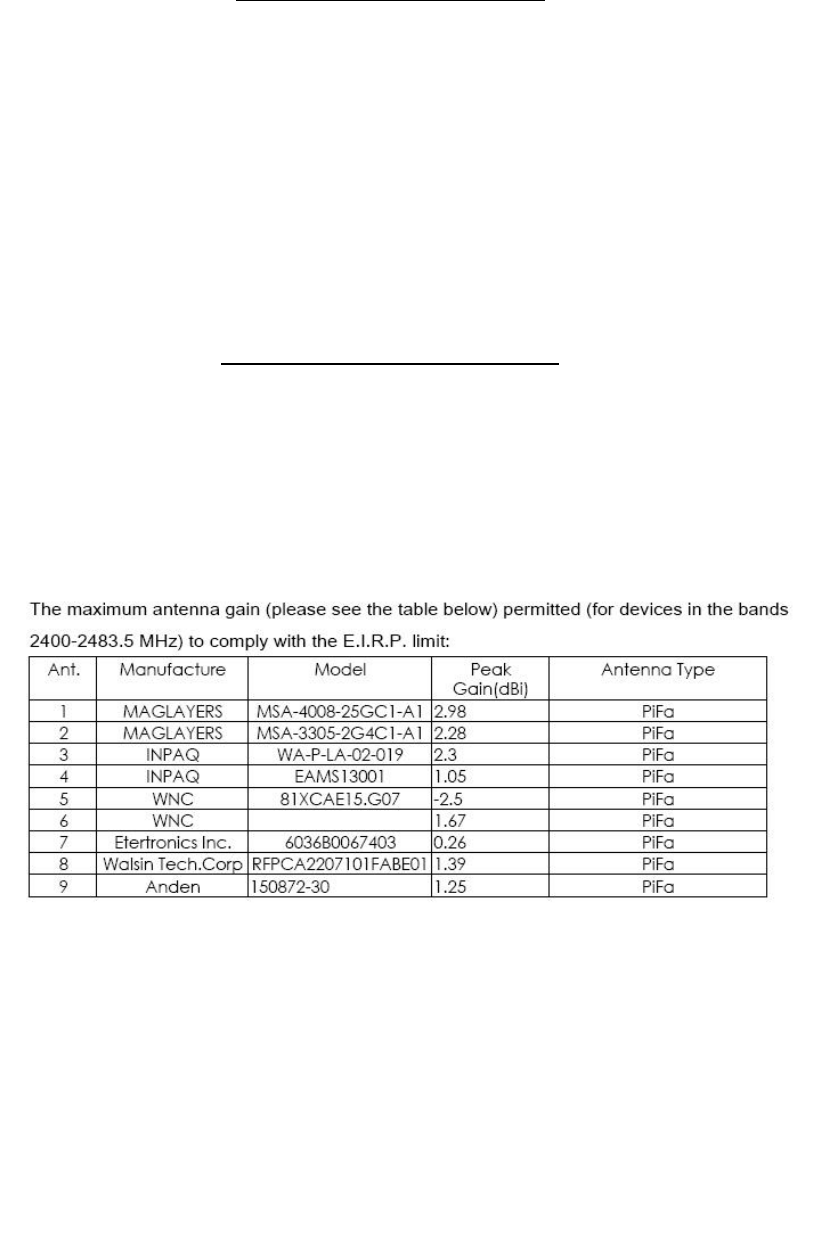
être installée de telle sorte qu'une distance de 20cm peut être maintenue entre l'antenne et les
utilisateurs. Le produit final doit être étiqueté dans un endroit visible avec l'inscription suivante: "Contient
des IC: 6100A-NM387".
=========================================================
Manual Information To the End User
The OEM integrator has to be aware not to provide information to the end user regarding how to
install or remove this RF module in the user’s manual of the end product which integrates this
module.
The end user manual shall include all required regulatory information/warning as show in this
manual.
Manuel d'information à l'utilisateur final
L'intégrateur OEM doit être conscient de ne pas fournir des informations à l'utilisateur final quant à la
façon d'installer ou de supprimer ce module RF dans le manuel de l'utilisateur du produit final qui intègre
ce module.
Le manuel de l'utilisateur final doit inclure toutes les informations réglementaires requises et
avertissements comme indiqué dans ce manuel.
This radio transmitter (AW-NM387,IC:6100A-NM387) has been
approved by Industry Canada to operate with the antenna types listed below with the maximum permissible gain
and required antenna impedance for each antenna type indicated. Antenna types not included in this list, having
a gain greater than the maximum gain indicated for that type, are strictly prohibited for use with this device.
All antenna's impedance is 50 ohms.